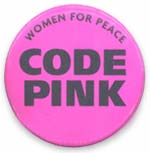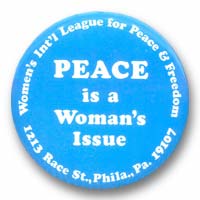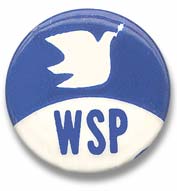|
  
Women's Peace Activism:
Forward into the Past? (2003)
Browse photos of the March 8, 2003 Code Pink March.
Read more articles in the War section
of this site.
 On
March 8, 2003, International Woman's Day, about ten thousand women accompanied
by roughly one thousand men and children marched down 16th St. in Washington
D.C. to protest the prospect of war on Iraq. There were sister demonstrations
around the world.
 They
called themselves Code Pink, a take-off on the government's color-coded
terror alert system, though hot pink was more the color of the day. They said
pink signifies "extreme danger to all the values of nurturing, caring, and
compassion that women and loving men have held." However, for the last century
the color pink has been used to designate femaleness. They
called themselves Code Pink, a take-off on the government's color-coded
terror alert system, though hot pink was more the color of the day. They said
pink signifies "extreme danger to all the values of nurturing, caring, and
compassion that women and loving men have held." However, for the last century
the color pink has been used to designate femaleness.
 There
is a long tradition of women identifying femaleness, usually motherhood, with
opposition to war. Carrie
Chapman Catt, soon to take the helm of the National
American Woman Suffrage Association, wrote in 1915 that "when war murders
the husbands and sons of women, destroys their homes, desolates their country
and makes them refugees and paupers, it becomes the undeniable business of women." There
is a long tradition of women identifying femaleness, usually motherhood, with
opposition to war. Carrie
Chapman Catt, soon to take the helm of the National
American Woman Suffrage Association, wrote in 1915 that "when war murders
the husbands and sons of women, destroys their homes, desolates their country
and makes them refugees and paupers, it becomes the undeniable business of women."
 US
women held their first modern anti-war march in New York City on August 29, 1914
to protest the war in Europe. Approximately 1,500 women wearing mourning
clothes marched in silence. The following January, delegates from women's organizations
ranging from the Daughters of the American Revolution to the Women's Committee
of the Socialist Party formed the Woman's Peace Party at Washington DC's New
Willard Hotel, choosing noted settlement worker Jane
Addams as their leader.
Its preamble stated that "As women, we feel a peculiar moral passion of
revolt against both the cruelty and waste of war..." US
women held their first modern anti-war march in New York City on August 29, 1914
to protest the war in Europe. Approximately 1,500 women wearing mourning
clothes marched in silence. The following January, delegates from women's organizations
ranging from the Daughters of the American Revolution to the Women's Committee
of the Socialist Party formed the Woman's Peace Party at Washington DC's New
Willard Hotel, choosing noted settlement worker Jane
Addams as their leader.
Its preamble stated that "As women, we feel a peculiar moral passion of
revolt against both the cruelty and waste of war..."
 Then
as now, US women were not alone in their belief that it was women's duty to oppose
war. In April 1915 over one thousand women from eleven European countries
plus the US met at The Hague to form a Women's Committee for Permanent Peace.
Addams became its president, and the WPP an affiliate. Then
as now, US women were not alone in their belief that it was women's duty to oppose
war. In April 1915 over one thousand women from eleven European countries
plus the US met at The Hague to form a Women's Committee for Permanent Peace.
Addams became its president, and the WPP an affiliate.
  Although
vilified in the press, the WPP grew until Congress declared war on April 6, 1917.
Women's organizations split, some continued their opposition while most
looked for ways to support the troops. In 1919 the WPP reorganized into the Women's
International League for Peace and Freedom (WILPF), still headed by Jane Addams.
The American section lobbied against conscription and for decreased military
appropriations, which angered the War Department. Although
vilified in the press, the WPP grew until Congress declared war on April 6, 1917.
Women's organizations split, some continued their opposition while most
looked for ways to support the troops. In 1919 the WPP reorganized into the Women's
International League for Peace and Freedom (WILPF), still headed by Jane Addams.
The American section lobbied against conscription and for decreased military
appropriations, which angered the War Department.
 Women's
peace activism didn't stop the Great War (World War I), or even prevent the United
States from entering it, but it did put a spotlight on women who said "no" to
war. When Jeannette Rankin of Montana, the first woman Member of Congress, was
one of 50 Members to vote "no" on the Declaration of War against Germany,
she was singled out for opprobrium. The New York Times later used her vote as
one more reason why women did not deserve suffrage. In 1918 WPP leader Emily
Greene Balch lost her faculty position at Wellesley College because of her work
for peace. Vice President Calvin Coolidge went so far as to castigate women's
colleges as hotbeds of radicalism in a 1921 magazine article. In 1922, Secretary
of War John Weeks denounced women pacifists as hysterics and traitors. Because
so many women and their organizations had argued against US involvement in the
European War, the Military Intelligence Division of the War Department kept many
of them under surveillance during and after the War. In 1923, a War Department
librarian published the "Spider Web Chart" linking prominent women
and organizations as part of "The Socialist-Pacifist Movement in America." In
addition to WILPF, these included the PTA, the YWCA, the General Federation of
Women's Clubs, the WCTU (Women's Christian Temperance Union), and the National
Federation of Business and Professional Women. Accusations of disloyalty were
used to defeat bills and resolutions urged by women's groups throughout the 1920s. Women's
peace activism didn't stop the Great War (World War I), or even prevent the United
States from entering it, but it did put a spotlight on women who said "no" to
war. When Jeannette Rankin of Montana, the first woman Member of Congress, was
one of 50 Members to vote "no" on the Declaration of War against Germany,
she was singled out for opprobrium. The New York Times later used her vote as
one more reason why women did not deserve suffrage. In 1918 WPP leader Emily
Greene Balch lost her faculty position at Wellesley College because of her work
for peace. Vice President Calvin Coolidge went so far as to castigate women's
colleges as hotbeds of radicalism in a 1921 magazine article. In 1922, Secretary
of War John Weeks denounced women pacifists as hysterics and traitors. Because
so many women and their organizations had argued against US involvement in the
European War, the Military Intelligence Division of the War Department kept many
of them under surveillance during and after the War. In 1923, a War Department
librarian published the "Spider Web Chart" linking prominent women
and organizations as part of "The Socialist-Pacifist Movement in America." In
addition to WILPF, these included the PTA, the YWCA, the General Federation of
Women's Clubs, the WCTU (Women's Christian Temperance Union), and the National
Federation of Business and Professional Women. Accusations of disloyalty were
used to defeat bills and resolutions urged by women's groups throughout the 1920s.
 Despite
these attacks, women's peace organizations proliferated until the Great Depression,
though over time they backed away from issues identified as feminist
or women's rights to focus on foreign policy. They argued that motherhood gave
women a special role as peacemakers. The rise of fascism put women's peace organizations
into a quandary and US entry into World War II put many out of business. Those
that survived campaigned against the loss of civil liberties and the placement
into camps of Americans of Japanese ancestry. Despite
these attacks, women's peace organizations proliferated until the Great Depression,
though over time they backed away from issues identified as feminist
or women's rights to focus on foreign policy. They argued that motherhood gave
women a special role as peacemakers. The rise of fascism put women's peace organizations
into a quandary and US entry into World War II put many out of business. Those
that survived campaigned against the loss of civil liberties and the placement
into camps of Americans of Japanese ancestry.
 Another
Red Scare infected the country after World War II, as it had after World War
I. This time women's organizations were not a special target; by then they
barely existed. The generally repressive atmosphere discouraged dissent since
those who disagreed with the government were often accused of being unAmerican, "exposed" in
the press, and denied employment. The husbands of several WILPF women lost jobs.
Nonetheless, WILPF's work was appreciated abroad. Two of its leaders were awarded
the Nobel Peace Prize— Jane Addams in 1931 and Emily Greene Balch in 1946. Another
Red Scare infected the country after World War II, as it had after World War
I. This time women's organizations were not a special target; by then they
barely existed. The generally repressive atmosphere discouraged dissent since
those who disagreed with the government were often accused of being unAmerican, "exposed" in
the press, and denied employment. The husbands of several WILPF women lost jobs.
Nonetheless, WILPF's work was appreciated abroad. Two of its leaders were awarded
the Nobel Peace Prize— Jane Addams in 1931 and Emily Greene Balch in 1946.
 Women's
peace activism was revived in 1961, when the Soviet Union resumed atmospheric
testing of nuclear devices after a three-year moratorium. As the US followed
suit, several women organized marches in sixty cities on November 1, in order
to bring women out of their kitchens to City Hall for a one-day "strike." Women's
peace activism was revived in 1961, when the Soviet Union resumed atmospheric
testing of nuclear devices after a three-year moratorium. As the US followed
suit, several women organized marches in sixty cities on November 1, in order
to bring women out of their kitchens to City Hall for a one-day "strike."  Women's
Strike for Peace (aka Women for Peace) was subsequently created to protest the
nuclear arms race. Projecting an image of housewifely respectability, WSP demanded
attention on the grounds that mothers were the protectors of life and women the
moral guardians of society. WSP's success led to a subpoena by the House UnAmerican
Activities Committee of a number of its activists. Women's
Strike for Peace (aka Women for Peace) was subsequently created to protest the
nuclear arms race. Projecting an image of housewifely respectability, WSP demanded
attention on the grounds that mothers were the protectors of life and women the
moral guardians of society. WSP's success led to a subpoena by the House UnAmerican
Activities Committee of a number of its activists.
 The
Viet Nam War brought a lot of young women to anti-war activity, but only some
of them joined the older women's peace organizations. Like the young men,
they wanted to do their own thing, so they sought to carve out a niche for themselves
in the many anti-war organizations that emerged in the late 1960s. There they
discovered their second class status in a movement where men could resist the
draft, but women could only counsel resistance. Young women were told that "girls
say yes to boys that say no" and otherwise relegated to service and support
functions. The
Viet Nam War brought a lot of young women to anti-war activity, but only some
of them joined the older women's peace organizations. Like the young men,
they wanted to do their own thing, so they sought to carve out a niche for themselves
in the many anti-war organizations that emerged in the late 1960s. There they
discovered their second class status in a movement where men could resist the
draft, but women could only counsel resistance. Young women were told that "girls
say yes to boys that say no" and otherwise relegated to service and support
functions.
  Many
rebelled and publicly told the established women's peace organizations what they
thought of the motherhood imagery on January 15, 1968. WILPF, WSP and other
groups brought 5,000 women to Washington as the Jeannette Rankin Brigade to present
Congress with a petition to end "the ruthless slaughter in Viet Nam." Among
them were a few dozen newly conscious young feminists who used the occasion to
stage their own protest. They carried a funeral bier for a "Burial of Traditional
Womanhood" and told the older women that the time had come to stop supplicating
and start acting. "Bury submission alongside aggression," they said.
The older women told them they were out of line, but everyone went home talking
about it. Many
rebelled and publicly told the established women's peace organizations what they
thought of the motherhood imagery on January 15, 1968. WILPF, WSP and other
groups brought 5,000 women to Washington as the Jeannette Rankin Brigade to present
Congress with a petition to end "the ruthless slaughter in Viet Nam." Among
them were a few dozen newly conscious young feminists who used the occasion to
stage their own protest. They carried a funeral bier for a "Burial of Traditional
Womanhood" and told the older women that the time had come to stop supplicating
and start acting. "Bury submission alongside aggression," they said.
The older women told them they were out of line, but everyone went home talking
about it.
 Thirty-five
years later the National Organization for Women loaned CodePink space in its
national office to organize the March 8, 2003 march to the White House. Thirty-five
years later the National Organization for Women loaned CodePink space in its
national office to organize the March 8, 2003 march to the White House.
Photos of the March 8, 2003 Code Pink March
by Jo Freeman
Please click on thumbnails to view the complete image

|
|

 Women's
Strike for Peace (aka Women for Peace) was subsequently created to protest the
nuclear arms race. Projecting an image of housewifely respectability, WSP demanded
attention on the grounds that mothers were the protectors of life and women the
moral guardians of society. WSP's success led to a subpoena by the House UnAmerican
Activities Committee of a number of its activists.
Women's
Strike for Peace (aka Women for Peace) was subsequently created to protest the
nuclear arms race. Projecting an image of housewifely respectability, WSP demanded
attention on the grounds that mothers were the protectors of life and women the
moral guardians of society. WSP's success led to a subpoena by the House UnAmerican
Activities Committee of a number of its activists.
![]()